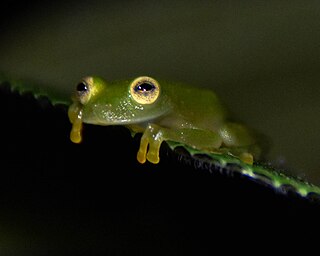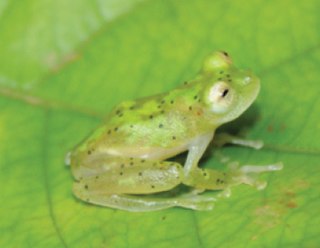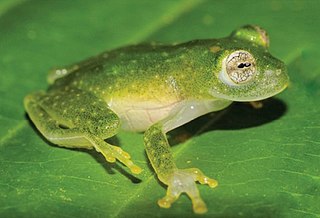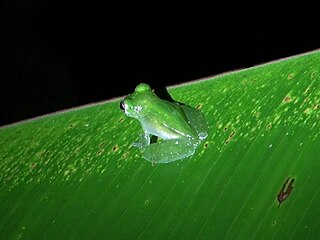
The glass frogs are frogs of the amphibian family Centrolenidae. While the general background coloration of most glass frogs is primarily lime green, the abdominal skin of some members of this family is transparent and translucent. The internal viscera, including the heart, liver, and gastrointestinal tract, are visible through the skin, hence the common name is given as glass frog. Glass frogs are arboreal, meaning they mainly live in trees, and only come out for mating season.

Hyalinobatrachium is a genus of glass frogs, family Centrolenidae. They are widely distributed in the Americas, from tropical Mexico to southeastern Brazil and Argentina.

Sachatamia ilex is a species of frog in the family Centrolenidae. It is found in eastern Nicaragua, Costa Rica, Panama, western Colombia, and western Ecuador. Common name Limon giant glass frog has been coined for this species, apparently in reference to its type locality in the canton of Limón, Costa Rica, and it is also known as the ghost glass frog.

Cochranella euknemos, sometimes known as the San Jose Cochran frog, is a species of frog in the family Centrolenidae. It is found in central Costa Rica and south/eastward to Panama and to the western flank of the Cordillera Occidental in Colombia. Some Colombian records might apply to Cochranella mache.
Hyalinobatrachium aureoguttatum is a species of frog in the family Centrolenidae. It is found in northern Ecuador, Pacific lowlands and western slopes of the Cordillera Occidental in Colombia, and eastern Panama. It occurs from near sea level to 1,560 m (5,120 ft) asl.

Hyalinobatrachium chirripoi is a species of frog in the family Centrolenidae. It is found in extreme northern Ecuador, northwestern Colombia, Panama, and Costa Rica, as well as in Honduras. The specific name chirripoi refers to the Chirripó Indians inhabiting the area of the type locality, Suretka in the Talamanca canton of Costa Rica. Common name Suretka glass frog has been coined for it.

Hyalinobatrachium colymbiphyllum, also called the bare-hearted glass frog, plantation glass frog and the cricket glass frog, is a species of frog in the family Centrolenidae that is found in moist forests, often near streams, in countries in Central America and South America. They are small, green frogs with many similarities to other glass frogs, however, they have the most transparent undersides of any glass frogs. Their transparent undersides make them ideal bio-indicators for how global warming and other threats are affecting the animals in the forests.
Hyalinobatrachium duranti is a species of frog in the family Centrolenidae. It is endemic to the Cordillera de Mérida, Venezuela. In Spanish it is known as ranita de cristal de Durant. Its natural habitats are montane cloud forests where it occurs along cascading mountain streams. Its status is insufficiently known.

Hyalinobatrachium fleischmanni, the Fleischmann's glass frog or northern glass frog, is a species of frog in the family Centrolenidae. It is found in the tropical Americas from southern Mexico to Ecuador. Specifically, these frogs occur in Mexico, Belize, Costa Rica, El Salvador, Guatemala, Honduras, Nicaragua, and Panama, Colombia, and Ecuador. Notice that this and related species have often been confused with each other, and the exact distribution depends on the source.
Hyalinobatrachium fragile is a species of frog in the family Centrolenidae. It is endemic to the Venezuelan Coastal Range. In Spanish it is known as ranita de cristal fragil.
Hyalinobatrachium guairarepanense is a species of frog in the family Centrolenidae. It is endemic to Venezuela, where it is found in locations in the Coastal Range at elevations between 720 and 1,000 m above sea level.

Hyalinobatrachium iaspidiense is a species of frog in the family Centrolenidae from South America. Its specific name refers Quebrada de Jaspe, its type locality.
Hyalinobatrachium orientale is a species of glass frog in the family Centrolenidae. It is found on the island of Tobago and in eastern Venezuela. Its common name is eastern glass frog. The Tobagonian population has been described as subspecies Hyalinobatrachium orientalis tobagoensis(Hardy, 1984). The latter is sometimes referred to as Tobago glass frog. H. orientale is distributed throughout the Central Eastern ranges of the Cordillera de la Costa in Venezuela and Tobago Island with an altitudinal range of 190 to 1200 meters.
Hyalinobatrachium pallidum is a species of frog in the family Centrolenidae. It is endemic to Venezuela. It is known from its type locality, Guacharaquita between La Grita and Páramo de La Negra in the Táchira state, and from a number of sites in the Sierra de Perijá, Zulia state. Its altitudinal range is 1,132–1,832 m (3,714–6,010 ft) asl. There is also an unconfirmed record from San Isidro in the Barinas state.

Hyalinobatrachium pellucidum, also known as the Rio Azuela glass frog, is a species of frog in the family Centrolenidae. It is found in lower montane rainforests on the Amazonian Andean slopes in Ecuador and Peru. The specific name pellucidum is Latin for "transparent" and refers to the transparent parietal peritoneum of this species.

The powdered glass frog or Chiriqui glass frog, Teratohyla pulverata, is a frog species in the glass frog family (Centrolenidae). It is found from north-central Honduras south to northwestern Ecuador.
Hyalinobatrachium talamancae is a species of frog in the family Centrolenidae. It is endemic to the Limón Province, Costa Rica. Its common name is Talamanca glass frog. Its natural habitats are premontane wet forests. It is a regularly seen frog in suitable habitat.

Hyalinobatrachium taylori is a species of frog in the family Centrolenidae. Its common name is Taylor's glass frog, and in Spanish, ranita de cristal de Taylor. It may represent at least two distinct species.

Hyalinobatrachium valerioi, sometimes known as the La Palma glass frog, is a species of frog in the family Centrolenidae. It is found in central Costa Rica and south to Panama and the Pacific lowlands and slopes of western Colombia and Ecuador; also in the Magdalena River Valley of Colombia.
Priscilla Latham Hollister Starrett was an American herpetologist who researched anuran (frog) morphology, systematics and behavior.












